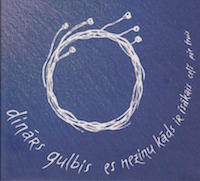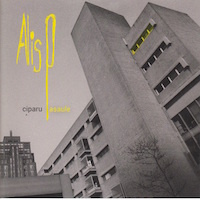A new face in the Latvian music scene is singer/songwriter/vocalist Dinārs Gulbis. Slowly, but steadily, he has become a notable Latvian ‘bard’, meaning he writes and performs his own songs, often with minimal accompaniment, following on from similar Latvian artists like Haralds Sīmanis and Kaspars Dimiters. Gulbis, who has gained notice via his expressive and passionate performances of songs at the Jānis Akurāters museum and the Autumn Bard Festival in 2010 (particularly songs with lyrics by Aleksandrs Čaks such as ‘Atzīšanās (Miglā asaro logs)’ and ‘Liepas satumst’), has now released his debut album – Es nezinu kāds ir īsākais ceļš pie tevis.
The album features songs with music written almost entirely by Gulbis, and lyrics by various modern Latvian poets. Gulbis provides vocals, and he is joined by Kaspars Zemītis and Kristaps Sudmalis on guitars, Ivars Sudmalis on piano, Toms Poišs on bass and Andris Buiķis on drums.
Gulbis’ wife, Daiga Gulbe, is a poet, and provides the words for three of the songs on the album (as well as the album artwork), including the somber and brooding ‘Kas paliek’ and the ominous, doleful ‘Robežai pāri’. Gulbe’s lyrics are deceptively simple, but reveal a depth that is well suited for Gulbis’ occasionally rough and raspy vocals. Particularly in ‘Robežai pāri’, where Gulbis sings about a difficult journey – ‘cauri man pukstoši zari plaukst, deniņos saules asmens duras, man jānoturas’ (pulsing branches grow through me, the sun’s blade pierces my temple, but I must stand firm).
Many different Latvian poets are represented on the collection, some well-known, and some whose names might not be as familiar, but no less notable. One such poet is Agita Draguna, whose lyrics provided the title of the album. Draguna’s expressive lyrics, at times romantic, but at times fragile and melancholic, are an appropriate fit for Gulbis’ world-weary voice, as he sings ‘Es esmu juties nodots kad man runā par mīlu’ (I have felt betrayed when one speaks of love to me), but still wishes to travel on that path – ‘Es nezinu kāds ir īsākais ceļš pie Tevis, bet es gribu to iet’ (I do not know the shortest road to you, but I want to travel it).
Poet Imants Ziedonis’ ode to solitude – ‘Vienam būt’ is a particularly powerful performance by Gulbis. He does not hesitate to use these lyrics to bare his innermost thoughts, and his need to be alone. As Gulbis sings ‘Lai paliek ar mani mana nelaime un manas mokas’ (My misfortune and suffering will stay with me), the listener can feel a soul in torment and one that wants to withdraw from all contact with society. Gulbis has a natural talent to reveal in music what a poet was thinking with their words.
Gulbis lives in the town of Salaspils not far from Rīga, and there is an ode to his place of residence – ‘Himna Salaspilij’, with lyrics by another resident of Salaspils, renowned Latvian poet Knuts Skujenieks. Skujenieks’ poems are often based on difficult and often harsh life experiences, but can be also very lyrical. In ‘Himna Salaspilij’, there is a juxtaposition of both the beauty of being on the banks of the Daugava River, but also the idea that one must never forget the blood that has been shed in wars in this area – ‘To maksu neaizmirst, kas samaksāta, lai mums zem saules mierā dzīvot ļauts’ (Do not forget the price that was paid that lets us live in peace under the sun). Though a non-traditional hymn, with Gulbis’ music and vocals, it becomes a powerful paean to Salaspils.
Es nezinu kāds ir īsākais ceļš pie tevis is a haunting listen and will stay with the listener long after it has finished. It is a confident, self-assured debut, and Gulbis’ displays a raw emotion and earnestness in his singing that is rare among other artists. One gets the feeling that Gulbis is particularly choosy about the poems he sets to music – each poem must speak to him personally and resonate deeply so that he can present a sincere and heartfelt performance. Dinārs Gulbis, with his emotive and ebullient vocals, has confirmed himself as an accomplished songwriter and performer.
For further information, please visit Dinārs Gulbis’ draugiem.lv page.

Es nezinu kāds ir īsākais ceļš pie tevis
Dinārs Gulbis
Lauska, 2015
Track listing
- Kas paliek
- Es nezinu kāds ir īsākais ceļš pie tevis
- Es esmu tikai pēdas smiltīs
- Robežai pāri
- Tieši tāpēc
- Manu jaunību sārtās buras
- Vai tu tici?
- Vienam būt
- Es tevi gribu
- Satikšanās vieta
- Tā bija
- Lūgšana
- Tā tu aizej
- Ceriņdziesma
- Vakar uzkritušais sniegs
- Himna Salaspilij
Egils Kaljo is an American-born Latvian from the New York area . Kaljo began listening to Latvian music as soon as he was able to put a record on a record player, and still has old Bellacord 78 rpm records lying around somewhere.






